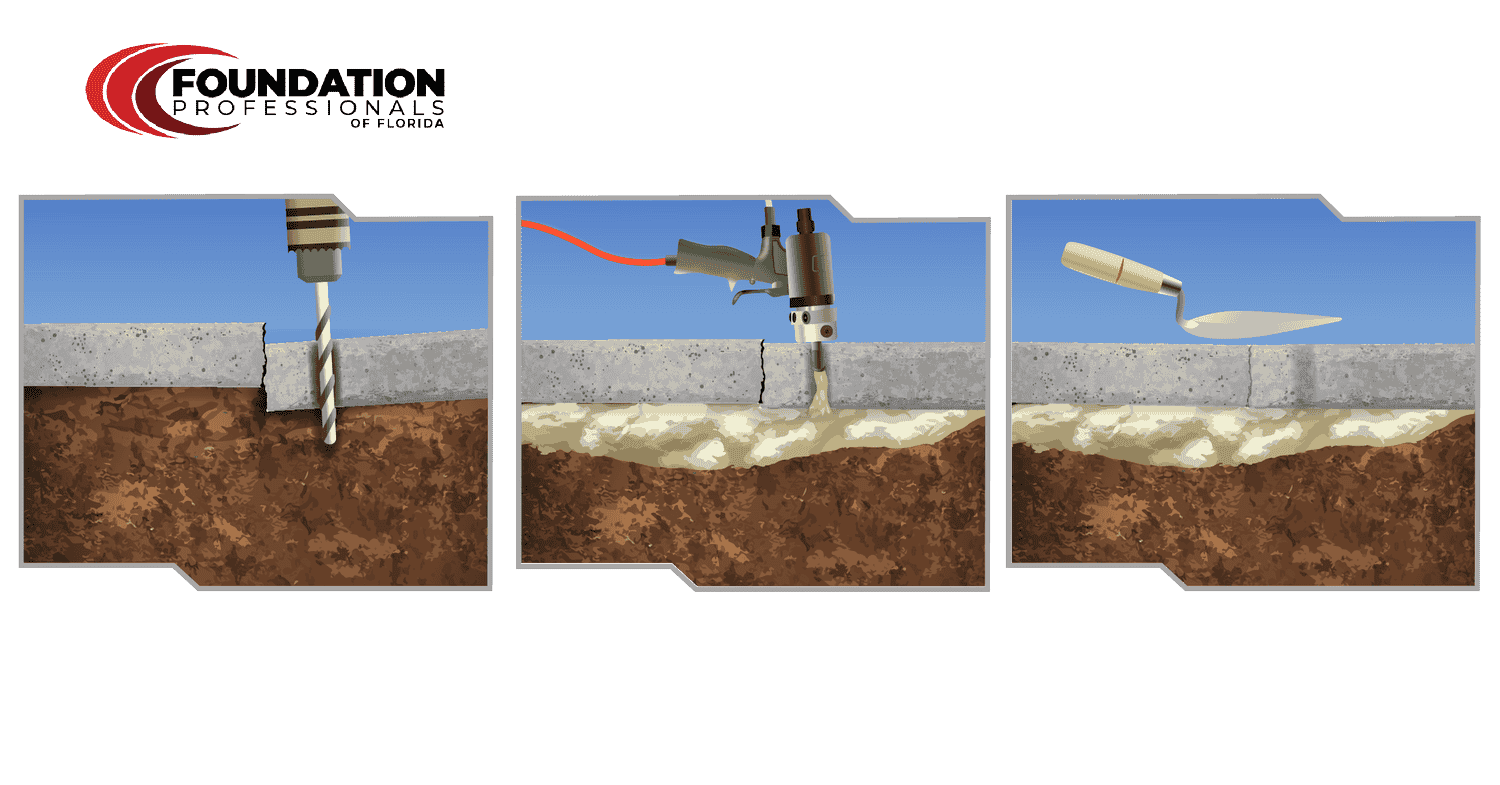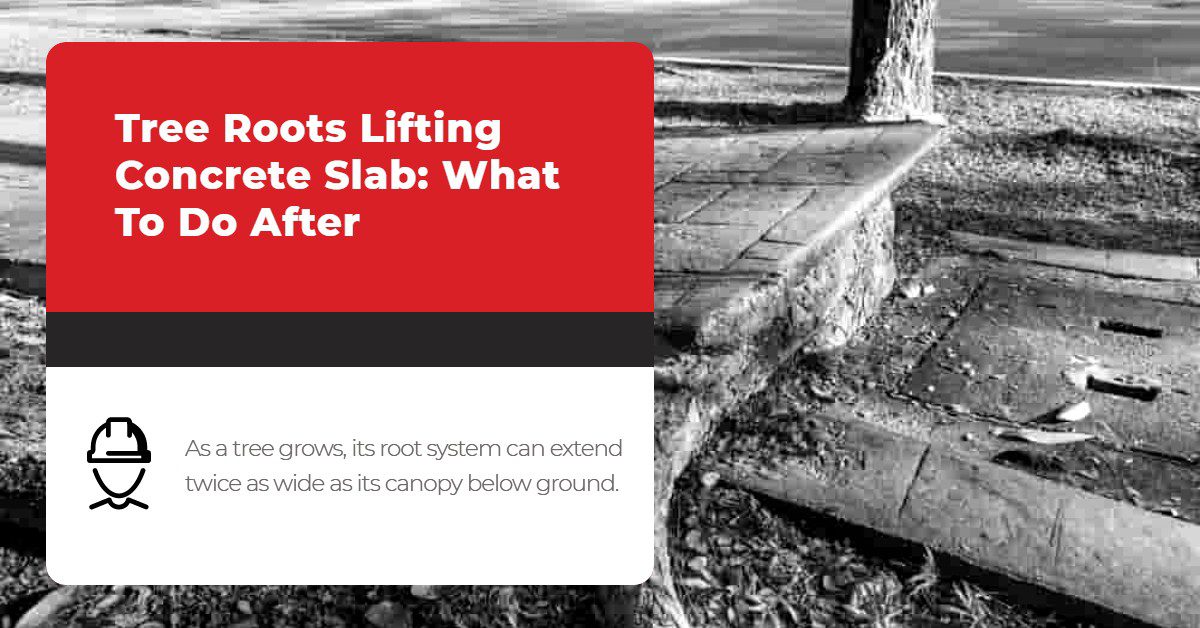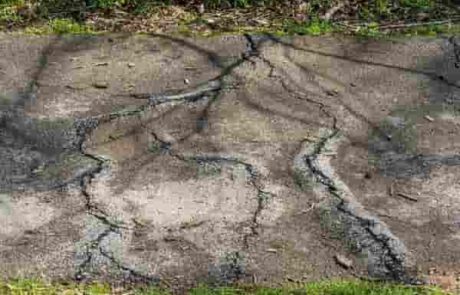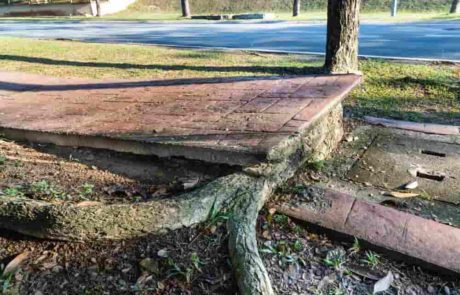If tree roots are lifting your concrete slab, you’re in the right place. We’re going to teach you why tree roots are lifting your slab and what to do after you remove them. In many cases, it’s not possible to move your concrete slab. So, you may have to remove the tree entirely. But, once you remove the tree and its roots, you’re left with voids under your concrete slab. What next?
Why Are Tree Roots Lifting My Concrete Slab?
As a tree grows, its root system can extend twice as wide as its canopy below ground. If those tree roots find their way under your concrete slab, they can lift it out of place and create annoying trip hazards. If your concrete slab is a sidewalk, you could get away with relocating your pathway somewhere else. But, if it’s the slab under your home or a driveway, moving your concrete might be too difficult. If the tree is still young, you might be able to relocate it to a better location. But if the tree is old, you might need to consider removing it completely.
What Happens After The Tree Roots Are Removed?
If you choose to remove the tree and its roots, you might be left with voids under your concrete slab, causing the sidewalk, patio, or driveway to sink into the dirt. Now you might be considering removing the slab as well. The good news is there’s another solution that works just as well. It’s called polyjacking.
What Is Polyjacking (Concrete Leveling)?
Polyjacking, also called concrete leveling, is when experts pump polyurethane foam underneath your sinking slab in order to lift it back into place. This method can be used for sidewalks, patios, driveways, and interior concrete slabs. Here’s how the process works.
- Step 1. Dime-sized holes are drilled into your concrete.
- Step 2. The polyurethane foam is injected through the holes until it fills the voids beneath your slab.
- Step 3. The foam expands and hardens, lifting up your slab back into place.
Once the concrete is leveled, the injection holes are patched, and any excess foam is cleaned off your slab.

Other Reasons Why Concrete Slabs Need Lifting
Besides tree roots, here are a few other reasons why concrete slabs sink and need lifting.
- Poor drainage – In order to prevent your concrete from sinking, experts recommend stopping water from draining toward your slab. If this happens, the water can wash out the soil from underneath your concrete slab, causing it to sink. Read more: Why Landscaping Around The Foundation Of Your House Is Important.
- Poor compaction – Before your concrete slab is poured, the soil underneath must be properly compacted. Compaction decreases the space between the soil particles, turning your dirt into a dense foundation. Without compaction, there could be voids under the slab, which will allow your concrete to sink.
- Poor site/soil conditions – Soil that contains a lot of clay is called expansive. Expansive soil swells when it absorbs water and shrinks when it dries. This up-and-down movement will cause your slab to sink.
Why Do Experts Choose Polyjacking?
There are six major benefits when it comes to polyjacking. That’s why experts choose it over mudjacking or replacing the slab entirely.
1. It’s fast – It only takes 15 minutes for the polyurethane foam to harden. This makes your concrete slab almost immediately usable again.
2. It’s non-invasive – Polyjacking does not require any heavy excavation, concrete trucks, or bulldozers.
3. It’s effective and lightweight – Polyurethane foam only weighs about 2.5 to 4 pounds per cubic foot. This means that the foam won’t sink and bring your slab down with it.
4. It’s environmentally friendly – Concrete lifting foam won’t leech any chemicals into your soil or grass.
5. It’s cheaper than replacing your slab – The cost to replace a concrete slab comes with many different expenditures including chipping away the old slab, hauling away the debris, bringing in concrete trucks, and pouring the new concrete.
6. It’s waterproof and lasting – Polyurethane foam is what experts call “hydrophobic.” Hydrophobic means that the foam will harden and stay hard even if it comes in contact with water.
Most experts will choose polyjacking over replacing your slab most of the time. The polyjacking foam will fill the voids beneath your slab, stabilize your concrete, and add extra strength to the structural integrity. Professional concrete leveling experts also use polyurethane foam for seawall repair. Over time, waves can erode the concrete on your seawalls and put your property and home at risk. With polyjacking, you can fill in voids and cracks rather than replacing the entire seawall.
Who Do You Call For Concrete Slab Lifting?
If you live in Florida, Georgia, Alabama, Mississippi, Louisiana, Tennessee, Kentucky, North Carolina, South Carolina, Virgin Islands, or the Florida Keys, and you need concrete slab lifting, call Foundation Professionals Of Florida. We don’t offer tree removal, but we can lift your concrete slab once the tree roots are removed and have left behind voids. We also provide foundation repair, basement waterproofing, crawl space repair, crawl space waterproofing, and more. Call today for your free estimate and inspection.




